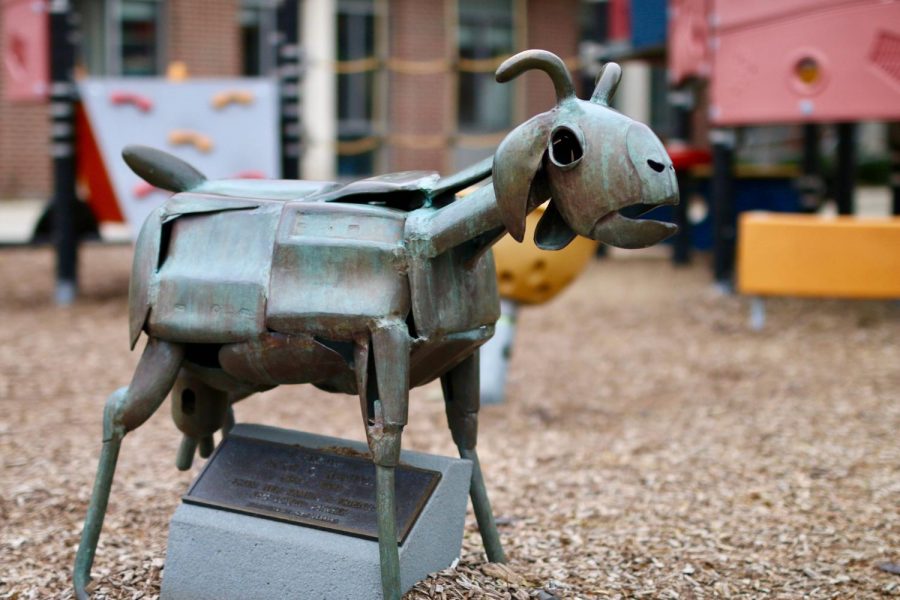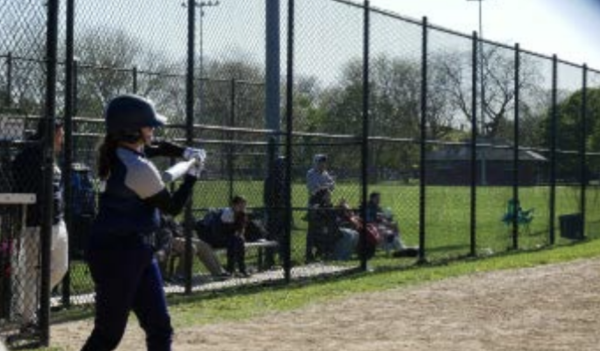The Guardian of the Playground
Annie Ravitz (‘85) Would Have Turned Fifty
Photo credit: Jenna Mansueto
The goat statue nearest the school covers a plaque bearing Ravitz’s name.
The brisk November air bites the small ears of a junior kindergartener in an aqua jacket as she mounts the frigid metallic body of a Ravitz goat sculpture situated a few feet away from the cold, desolate bleachers. Looking south with a slightly open mouth, the goat guards the playground and its young guests and has for decades. Underneath it, a faded black plaque with faded gold letters reads, “In memory of Anne C. Ravitz.”
Anne “Annie” Ravitz, ‘85, who died in Paris the summer before her junior year of high school at Parker, would have turned fifty years old this year. “She was seemingly always happy, always smiling,” Herbert “Hubie” Greenwald, a classmate and friend of Ravitz’s—said. “I remember her always being outgoing and this sort of giggly girl.”
Greenwald and Ravitz, who both came to Parker for Junior Kindergarten, were close friends growing up. In fact, Greenwald met her when they were about three years old. “We played together even before we were at Parker,” Greenwald said, “because our parents were friends.”
While spending a summer abroad in Paris—a trip for which she was excited, Ravitz was struck by a car. Her class, in response to her death, sang James Taylor’s somber “Fire and Rain” at a memorial service held in her honor. “That memorial service was hard, difficult,” Greenwald said. “At that point in your life, you’re 15-years old—I think—and you’ve never contemplated your own mortality and then find out that someone whom you knew your whole life was gone in an instant was difficult, it was painful, and really profoundly sad.”
Joel Dure, former Parker French teacher, has fond memories of Ravitz. “She was beautiful, she was anything and everything a teacher could expect from a student,” Dure said. “She was intelligent, she was extremely passionate about French, and she cared a lot about me and cared a lot about her classmates.”
According to Dure, Ravitz went to France to immerse herself in the language, with the intention of skipping a level in French (from French II to IV). “I can still feel this rigid smile on her face, and she had a voice—a very distinct voice,” Dure said of Ravitz. “I can hear it right now. It sounds so different than any other voice. It’s a raspy voice, but at the same time, it’s a voice that welcomes someone to her world.”
Dure still can recall the day that he found out about her death. “I was working at Parker summer camp, and the director of the campus, Mr. Stephen, called me and he said, ‘Joel, please sit down,’ and I was actually not sure exactly why because it was about one o’clock in the afternoon,” Dure said, “and he told me that he had great difficulty and sadness to tell me, and that’s when he told me that Annie was killed in Paris.”
Dure felt numb for the rest of the afternoon. “It was hard to react to that,” Dure said. “She was a perfect person to me. It’s a lot easier to say after a person is no longer around, but she was the perfect kid at Parker. And I’m sure that you will hear that also from many of her friends.”
Barri Klutznick, ‘85, a camp friend of Ravitz’s at Forest Acres Camp in Fryeburg, Maine, thought highly of Ravitz. “She was sweet and silly and very optimistic, she had a great laugh, and she was happy,” Klutznick said. “I don’t remember her ever not smiling.”
Klutznick remembers the memorial service. “We sang some songs that she really loved,” Klutznick said. “We all got to get up and talk about her.” Klutznick had known Ravitz since she moved to Ravitz’s neighborhood in first grade. Since moving to California, where Ravitz is buried (Ravitz is buried in Palm Springs, where her mom moved after Ravitz’s death), Klutznick calls Principal Dan Frank annually to ask him to place flowers beneath the playground goat structure bearing the plaque honoring Klutznick’s childhood friend.
The sculptor of the goat statues, John Kearney, is responsible for various works of art throughout the school and the city of Chicago, including the locally famous statues outside of Oz Park. His legacy permeates Parker’s halls as students often admire his work, which includes the metallic horse statue just outside the auditorium.
The goat sculptures spark vivid memories among various members of the Parker community, including middle school students. “When we were little, we would play tag around them,” seventh-grader Mortimer Buckley said. “We would just use them, jump all over them. It was just a fun obstacle to use.”
Buckley is not the only middle schooler who remembers playing on the goats.“I thought they were pretty unique,” seventh-grader Nate Manilow said. “We would pretend to ride them like going on an adventure when I was really little.”
Older students also remember the statues. “My main memory is just playing on them,” junior Beatrice Turner said. “We would all just sit on each goat and pretend like we were going on a journey and everything.”
“I remember when I was in JK and SK, and the younger grades, playing on the goats and having fun with them with my friends,” sophomore Adele Lowitz said. “I always thought that they looked so cool and were such a cool addition to the playground and made it really beautiful.”
The goats were not the only way Parker honored Ravitz. According to Parker archivist and former teacher of Ravitz Andy Kaplan, rhododendron bushes were planted in her honor before the courtyard was redone. While the rhododendrons did not survive the construction, the goat statues remain. “I remember when the goat statues were out on the playground when they were first put out there,” eighth-grade science teacher Anne-Marie Fries said. “The kids just loved the goat statues because you could always see them at recess playing around them.”
Fries recalls how students have interacted with them. “They would pet them, they would laugh, they would play hide-and-seek around them,” Fries said. “Everybody just gathered around the goats, they just loved the goats.”
While the current generation of young students plays tag around the goats, rides them, and goes on journeys with them, the older generations are reminded of Ravitz’s raspy, welcoming voice carrying words that encapsulate the message inscribed on the plaque below in faded, gold, italicized lettering: “She loved Parker.” She spent twelve years of her life here and will remain here forever, guarding the playground and its young guests.












